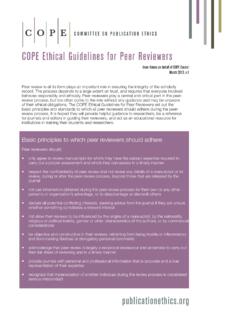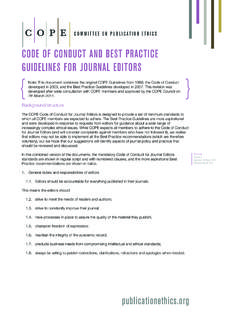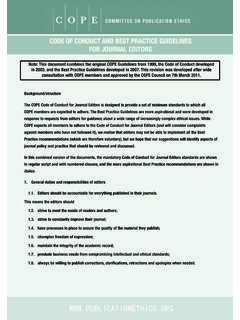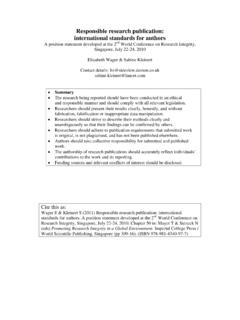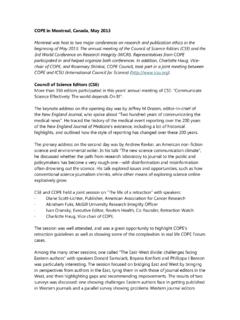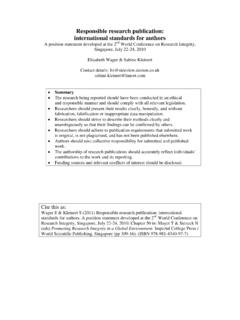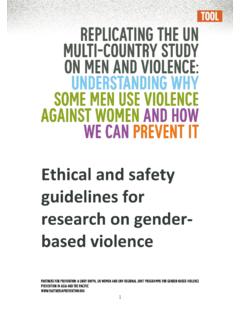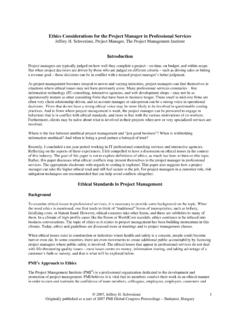Transcription of COPE Ethical Guidelines for Peer Reviewers
1 COPE Ethical Guidelines for peer ReviewersCOPE CouncilPeer Reviewers play a role in ensuring the integrity of the scholarly record. The peer review process depends to a large extent on the trust and willing participation of the scholarly community and requires that everyone involved behaves responsibly and ethically. peer Reviewers play a central and critical part in the peer review process, but may come to the role without any guidance and be unaware of their Ethical obligations. Journals have an obligation to provide transparent policies for peer review, and Reviewers have an obligation to conduct reviews in an Ethical and accountable manner.
2 Clear communication between the journal and the Reviewers is essential to facilitate consistent, fair and timely review. COPE has heard cases from its members related to peer review issues and bases these Guidelines , in part, on the collective experience and wisdom of the COPE Forum participants. It is hoped they will provide helpful guidance to researchers, be a reference for editors and publishers in guiding their Reviewers , and act as an educational resource for institutions in training their students and review, for the purposes of these Guidelines , refers to reviews provided on manuscript submissions to journals, but can also include reviews for other platforms and apply to public commenting that can occur pre- or post-publication.
3 Reviews of other materials such as preprints, grants, books, conference proceeding submissions, registered reports (pre-registered protocols), or data will have a similar underlying Ethical framework, but the process will vary depending on the source material and the type of review requested. The model of peer review will also influence elements of the of peer reviewThere are different types or models of peer review, all of which have various advantages and disadvantages. See the COPE document Who owns peer reviews?1 (section titled models of peer review ) for an explanation of various peer review models.
4 It is important to be aware of the model of peer review that the journal or platform uses before agreeing to undertake the peer review. The chart below, reproduced with permission from QUT, Australia, identifies key elements of the various models related to processes in peer review. Reviewers should understand their responsibilities related to confidentiality of the process and ownership of the review product based on the model of peer review being used. this as: COPE Council. Ethical Guidelines for peer Reviewers . September 2017. 2 Published September 2017 Version 1 Published March 2013 ht V XK TModels of peer review continuedThere are many different models of peer review.
5 A peer review process may operate to almost any combination in the following table by selecting one option from each row:TIMING PrePrints Pre-publication Post-PublicationIDENTIFIABILITY Double blind Single blind OpenMEDIATION Editors mediate all Reviewers interact with Reviewers and authors all interactions between one another openly interact with one another Reviewers and authors openlyPUBLICATION peer reviews are peer reviews are peer reviews are not published published but not signed published and signedFACILITATION Review facilitated Review facilitated Review facilitated by a journal by a third-party by authorsOWNERSHIP Review owned by
6 Review owned by Shared or mixed a journal or third party the authors of the reviews ownership of reviewsUsing the chart above, a standard, blinded, peer review process for a journal could be: Pre-publication; Single blind; Editors mediate all interactions between Reviewers and authors; peer reviews are not published; Review is facilitated by a journal; Reviews owned by the authors of the reviews. Being a reviewerProfessional responsibility: Authors who have benefited from the peer review process should consider becoming peer Reviewers as a part of their professional responsibilities. Some journals require a formal process of appointment to the review panel, and some require specific expertise; anyone interested in becoming a reviewer should look for the journal Guidelines on peer review and follow any requirements posted.
7 In order to assign appropriate Reviewers , editors must match Reviewers with the scope of the content in a manuscript to get the best reviews possible. Potential Reviewers should provide journals with personal and professional information that is accurate and a fair representation of their expertise, including verifiable and accurate contact information. It is important to recognize that impersonation of another individual during the review process is considered serious misconduct ( see COPE Case 12-12: Compromised peer review in published papers). When approached to review, agree to review only if you have the necessary expertise to assess the manuscript and can be unbiased in your assessment.
8 It is better to identify clearly any gaps in your expertise when asked to a reviewer continuedCompeting interests: Ensure you declare all potential competing, or conflicting, interests. If you are unsure about a potential competing interest that may prevent you from reviewing, do raise this. Competing interests may be personal, financial, intellectual, professional, political or religious in nature. If you are currently employed at the same institution as any of the authors or have been recent ( , within the past 3 years) mentors, mentees, close collaborators or joint grant holders, you should not agree to review.
9 In addition, you should not agree to review a manuscript just to gain sight of it with no intention of submitting a review, or agree to review a manuscript that is very similar to one you have in preparation or under consideration at another : It is courteous to respond to an invitation to peer review within a reasonable time-frame, even if you cannot undertake the review. If you feel qualified to judge a particular manuscript, you should agree to review only if you are able to return a review within the proposed or mutually agreed time-frame. Always inform the journal promptly if your circumstances change and you cannot fulfil your original agreement or if you require an extension.
10 If you cannot review, it is helpful to make suggestions for alternative Reviewers if relevant, based on their expertise and without any influence of personal considerations or any intention of the manuscript receiving a specific outcome (either positive or negative). Conducting a reviewInitial steps: Read the manuscript, supplementary data files and ancillary material thoroughly ( , reviewer instructions, required ethics and policy statements), getting back to the journal if anything is not clear and requesting any missing or incomplete items you need. Do not contact the authors directly without the permission of the journal.

